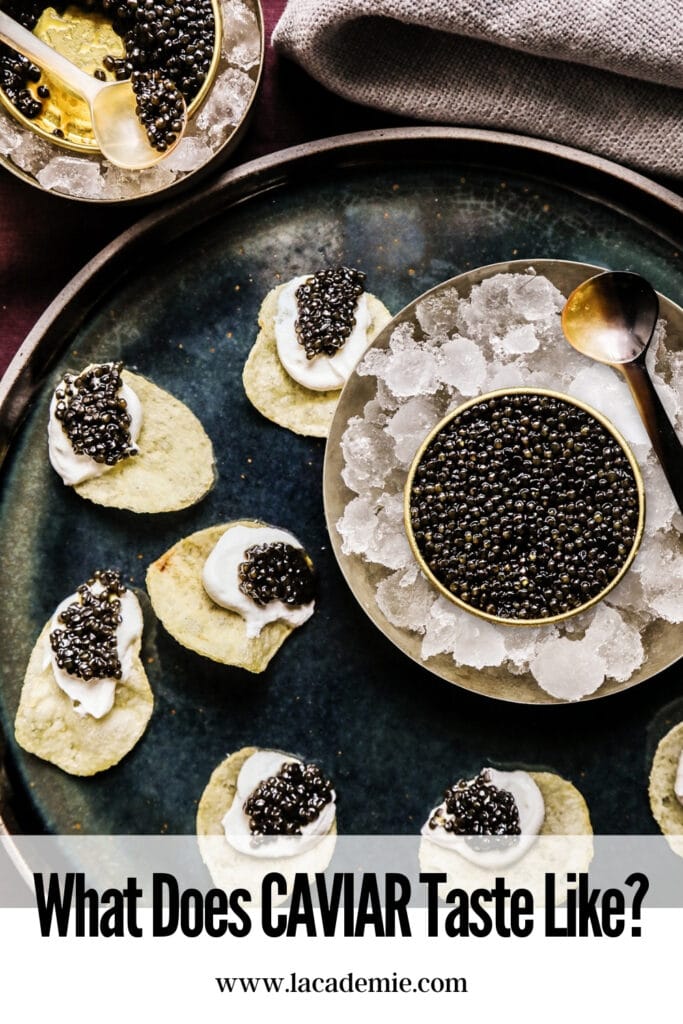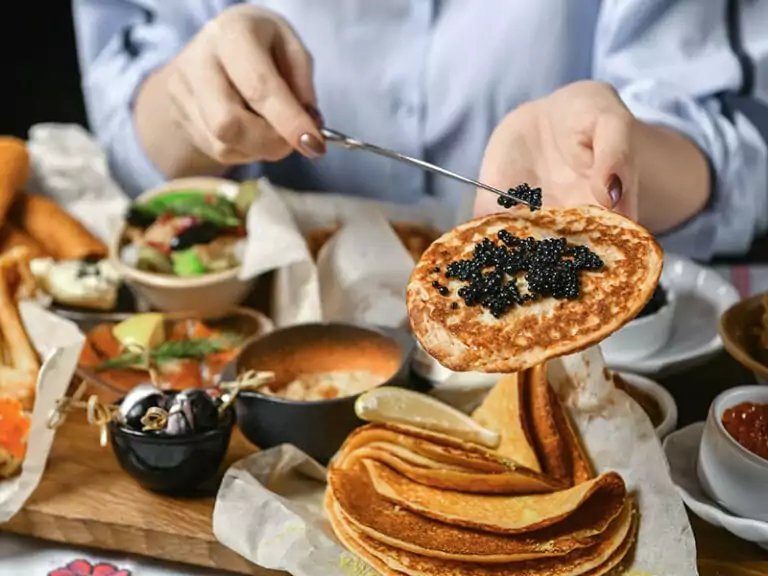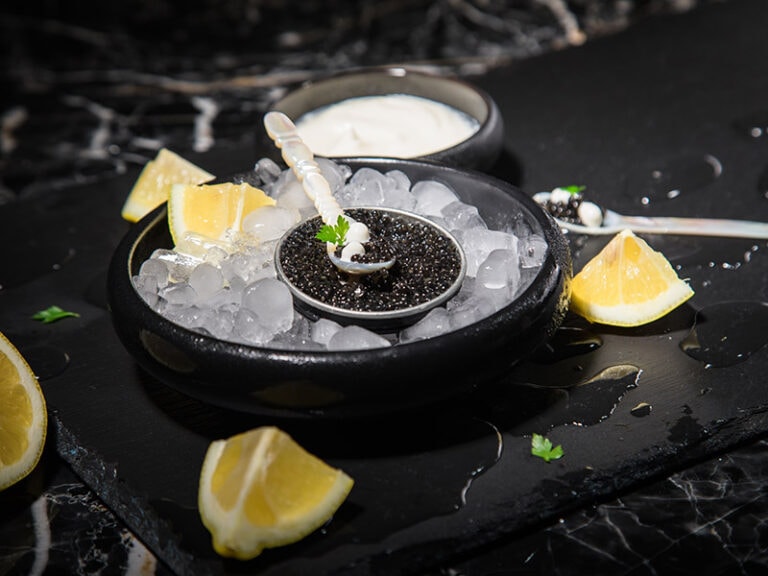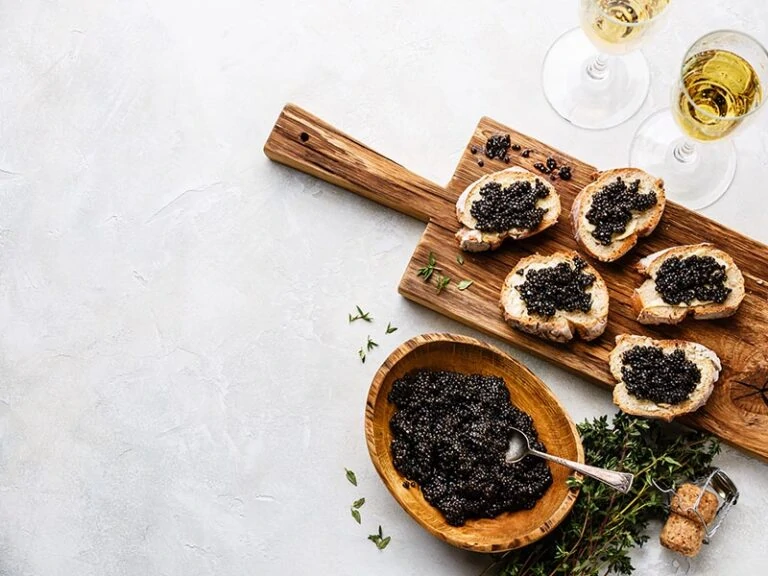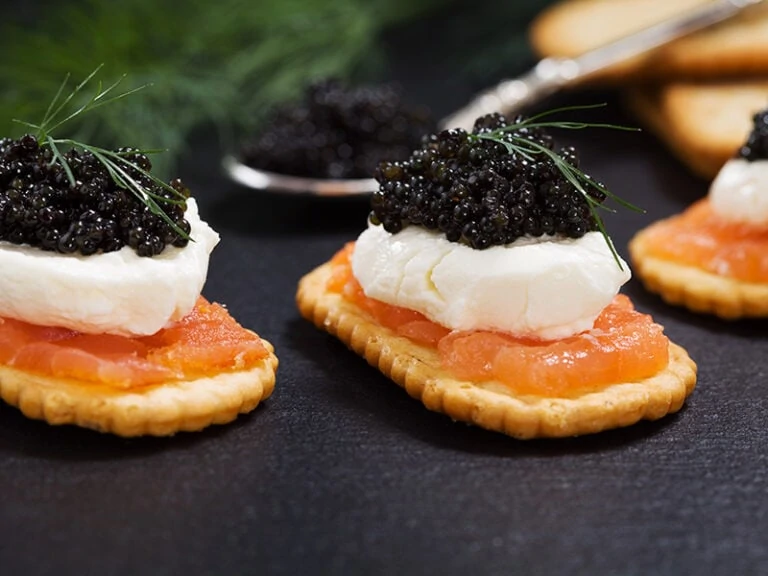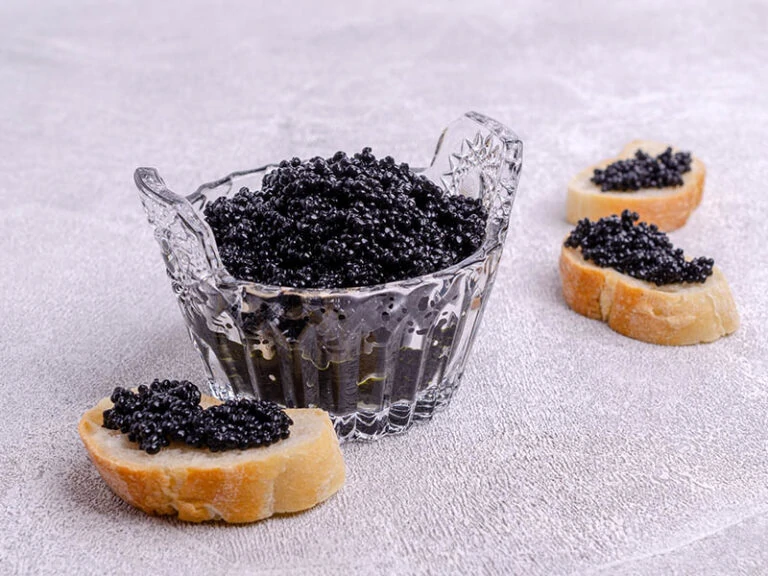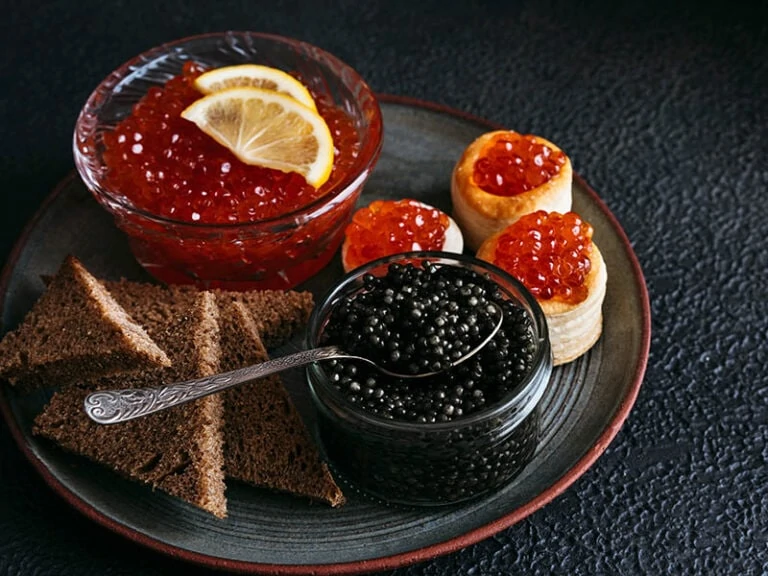“What is the taste of caviar?” is a common question that I’ve heard a lot. But first, do you know what caviar is? It is one of man’s oldest delicacies of fresh and blessed eggs. However, some of you might haven’t tried it before.
They have a shiny texture with the sockets roll on and glitter down your tongue firmly, and every egg is distinct. You can enjoy it alone, or prepare other foods to combine with your caviar. Of course, their flavors will blend perfectly to make the most delicious dishes.
The caviar has no excess fat and is smooth. When you bite the eggs, an explosion of flavors with a peculiar and scorching taste comes up.
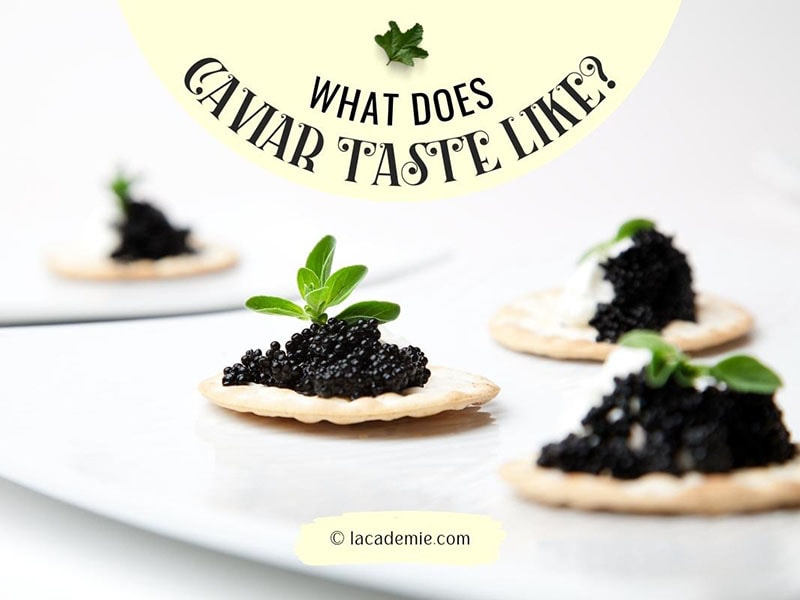
Along The Taste History
Known worldwide as a luxurious food, caviar consists of certain varieties of fish, dried, salt, and unfertilized, roe. Roe is ripe, fresh, or pasteurized egg masses. Pasteurized roe is not as delicious as fresh roe.
Why Does Caviar Cost So Much?
Everyone knows how costly caviar is, but are you ever curious about the reason for caviar’s expensive cost? Let me tell you why.
Traditional caviar is derived from the roe of Caspian and Black Sea wild sturgeon fish. However, people also use other roe fishes to make caviar. Despite the difference between salmon and trout, they both can be used to produce caviar.
The fish caviar other than sturgeon may be considered caviar as a “substitute” instead of real caviar. Since it is very costly, it is regarded as a luxury food. The price can be up to $8,000-$16,000 per kilogram, depending on the standard of caviar!
The fish it produces are rare and endangered. In addition, it is a time-consuming and costly method to harvest fish for their eggs.
Taste Caviar Around The World
Caviar is sometimes eaten on crackers or bread as a garnish. Since the Ancient Greeks and Romans, caviar has been reserved for the top echelons. This transition was noticed in the late 1800s as sturgeon abundant in many US rivers.
Sturgeon, however, were overfished for caviar, with their numbers declining rapidly, both around the world and in the US. By the 1960s, the price of caviar had once again increased markedly due to low supplies.
Today the world’s most rare and costly caviar is derived from beluga sturgeon living in the Caspian Sea. Beluga caviar is famous for its huge, fluffy, black, or silver eggs.
Taste Criteria To Consider
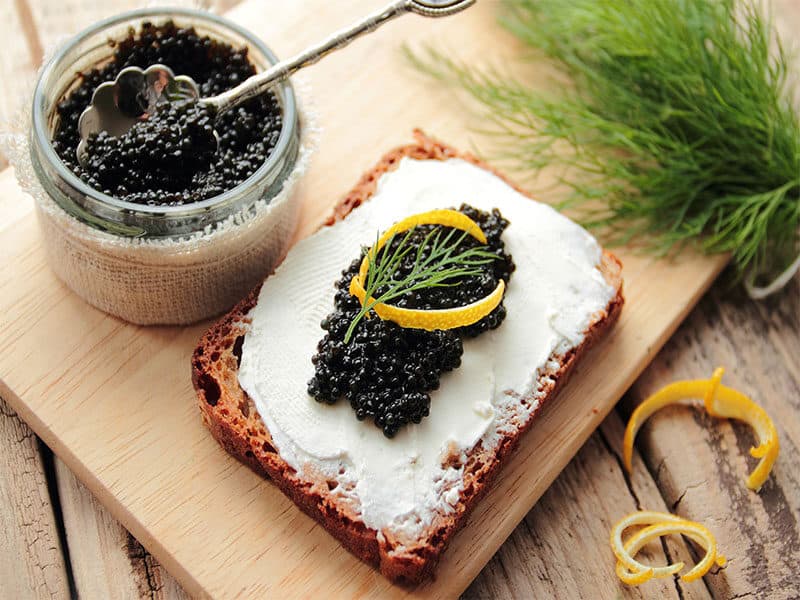
The pops of the eggs release a rich buttery consistency that includes both taste sensors and olfactory on the tongue. According to scientists, the ability to eat increases the sensation of smell and taste.
Caviar in the mouth, you will have a small hint of sweet, nutty, or something hard to express. Any answer to “what tastes caviar-like” involves excessively salty or fishy depend on its value.
Here I am summing up for you the critical factors; let’s see!
- The caviar’s value, like the quality of the scale and color, would be evaluated. Moreover, the true color of caviar depends on the species of fish. The big and mature eggs of fresh Osetra or Beluga caviar, for example, have a unique texture, vibrant brightness, and intense taste.
- Mayonnaise disguises a salty flavor of low-cost caviar with coated egg salad or another snack such as cheddar cheese.
- If the caviar umami evokes a delicate hint of ocean-fresh air
- Is caviar eaten at fresh or at fluctuating temperatures for so many days of storage?
- An unnatural metallic taste or smell may suggest that this delicate fare is not managed correctly.
How Caviar Taste Like?
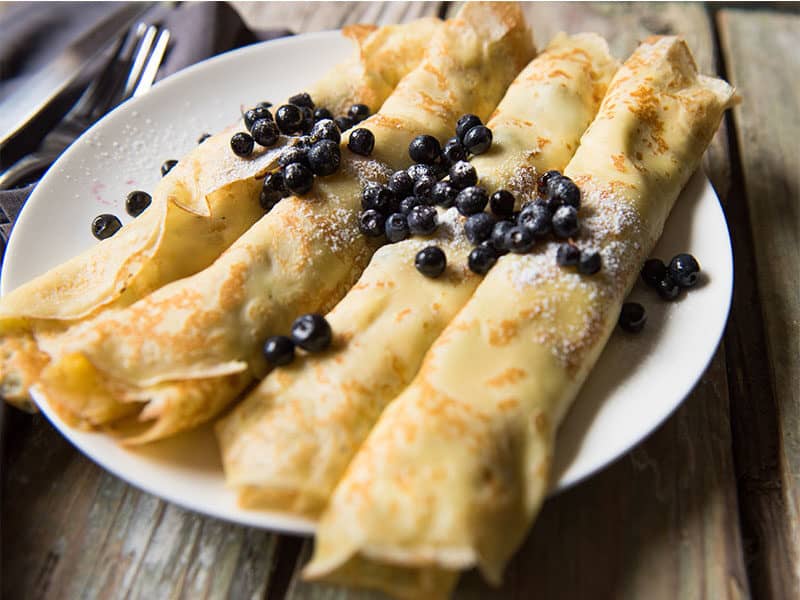
Some caviars have buttery, velvety, or smooth notes. Whereas you are new to the delicacy, it’s hard to keep the high-level complexity, and the ways of serving caviar can also affect its taste. A variety of different styles are critical to notice; next is the texture and taste of caviar.
Grade Caviar Via Tastes
Caviar is graded into two levels by experts qualified in quality. Apart from the taste, size, clarity, egg color, aroma, and firmness include factors for grading.
Grade A caviar consists of the largest, firmest, most intact eggs with a delicate flavor and color. Grade B caviar can be delicious or decadent and is made up of less uniform or soft eggs.
Caviar’s initial sense is that it tastes salty. Modern tastes even less salt than in past centuries is considered palatable. High salt was required once to save spoilage foods. However, too much salt will lead to heart disease and high blood pressure. It’s about 15 different tastes, from one roe to the next is never the same.
That’s why caviar tastes are too complex for beginner roe eaters to explain. The taste of caviar can be an enigmatic feeling, which is more like the sea itself than any identifiable touch.
Varies Of Taste
About 27 separate sturgeon species have been found, and many more non-sturgeon fish are raised in fine caviar with their roe. The taste of each species is distinct, but caviar from the same fish type will taste differently based on several factors. Check them out!
- The fish’s health
- The fish’s size and age
- Living location
- Wild-caught or farm-raised
- Feed and food intake type
- The environment’s water quality
- Time and place harvesting the roe
- Fresh or frozen roe after harvesting
- The salt quantity in production
- Pasteurized or un-pasteurized roe
- The container packed the roe
- The storing period of caviar
There are typical motives for the caviar taste: a sea breeze, a hint of sea salt, the delicacy of fresh fish. Smooth and nutty, often filled with sweet saltiness, spring up and fill your tongue, like good raw but richer oysters. Have you ever try?
The Quality Of Types
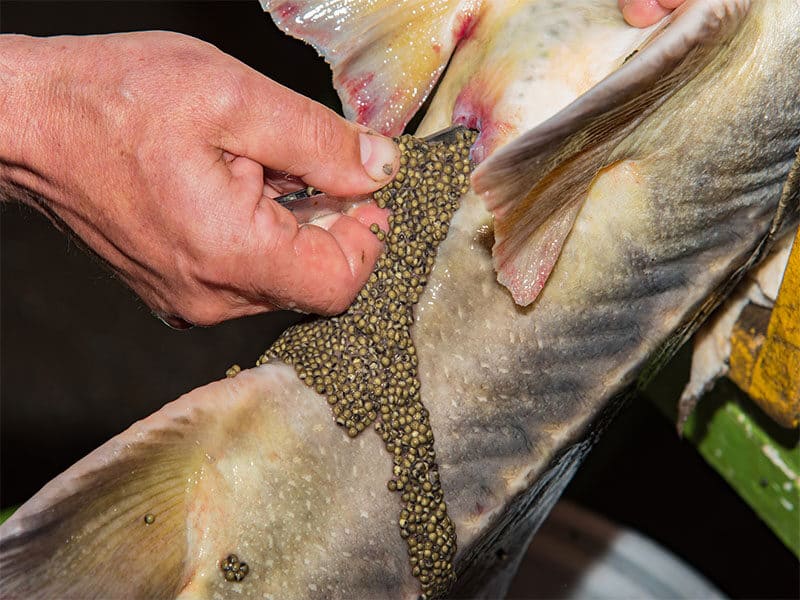
Caviar of highest quality is from the Caspian Sea nations, home to the sturgeons of Osetra, Sevruga, and Beluga. For hundreds of years, caviar has dominated Russia and Iran, producing caviar of the finest quality and most common in the world.
China has recently become a significant caviar exporter. There is still more demand than supplies for natural sturgeon caviar. It’s a lot more; check them all!
Why Is Caviar A Delicate Matter?
Caviar is a delicacy of nature. You can say that one of caviar’s defining features is that it’s a balanced lifestyle filled with B12 vitamins, protein, and amino acids. Any move in making caviar accessible to you is part of a sensitive, time-consuming, and work-intensive process.
Rarity
Depend on the species; female sturgeons begin to produce eggs only after seven to 20 years. The maturity of a beluga can take up to 20 years.
Only every few years, the female fish spawns. The most desired is Caspian caviar, but trade in the wild caviar protects the critically endangered sturgeon species.
Short Life-Shelf
The natural nutty flavors will shine when caviar is lightly salted. The best quality caviar is this kind of caviar, called “malossol,” but just a couple of weeks.
Manual Collecting
You can find a manual harvesting procedure right in every package of caviar. For the eggs to maintain consistency, they are carefully removed from the fish, cleaned, and hand prepared. Analyzed the entire supply of up to two million eggs and discarded all poor ones.
Various Types Of Caviar
Caviar is a natural product that depends on fish, weather, season, and process. There’s also a vegan caviar type if you can’t tell whether caviar is considered vegan or vegetarian. And while the vegan variety might not taste as good as the authentic one, it’s definitely worth a try.
As for authentic kinds of caviar, you can say that like wine, Oscietra caviar can be better than a low-quality Beluga under the correct situation; some connoisseurs prefer it. Below, you will find an overview reference. There are three major types:
Beluga & Beluga ‘000’
The best kind comes from the Iran-Russian Caspian Sea and the beluga sturgeon at risk (huso huso). It is forbidden to import to the USA for many reasons.
Perhaps due to this omnivorous protein-rich diet, the beluga eggs are the roundest, largest, and most succulent. The color, crystal-grey, the best, and the ‘000’ class is the best quality for these
precious eggs—the darker the grey shade, the little zero numbers.
Oscietra, Ossetra, Or Osetra
Oscietra is a golden-brown hue, but it is green or dirty ivory sometimes. It’s slightly smaller and softer than beluga, with a complex and nutty taste and a mild aftertaste.
The tasting is a bit fishier by less creamy than beluga; some connoisseurs prefer it. The sturgeon of oscietra is omnivorous and is often used to escape predators while diving on the seabed, and it can be fascinating and rich.
Sevruga
Sevruga caviar is the least rare of the three, with smaller eggs than oscietra and beluga, from the sevruga sturgeon. It’s graded via colors but typically jet-black. It’s more in your mouth, more pungent in the taste of sea salt.
Also, there are some of the other types:
Baerii, Baïka or Siberian
This is from the sturgeon Acipenser baerii. It’s not so much an aftertaste silky, pure and refreshing.
Sterlet
The caviar sterlet is rare, eaten mainly by royalty in the past. It’s got tiny pearls of gold.
White Sturgeon Caviar
This type is derived from Acipenser transmontanous in the Eastern Pacific Ocean, a close relative of oscietra. Many are from California, some of which are farmed in Italy. It’s mild, creamy, and buttery, you can see.
Kaluga
You almost have to bit the second-biggest egg after beluga, bursting and taut (cardinal sin). They come from Huso Dauricus sturgeon, originally from the Amur River in China.
The eggs are golden in hue and shiny light to deep brown. In China, most are produced. It has an elegant, robust, bright, and refreshing taste.
Daurenki
Huso dauricus and Acipenser schrenckii made caviar from the eggs of a hybrid. Tauter, larger eggs, rich in umami taste than baerii.
Platinum
Caviar with Acipenser baerii of a gueldenstaedtii hybrid. Dark grey to ebony and deep notes of hazelnut.
Schrenckii
From Acipenser schrenckii’s rare Japanese. Nutty and buttery, golden-shiny amber brown. Found in Russia and China river basins.
Caviar from hybrid fish is also grown. These fishes are grown to maturity much faster, and therefore the cost of caviar is reduced.
Signs Of Poor Taste Caviar
Drink water or sparkling waters between various varieties to purify your palate when you taste a range of different caviars. Plus, you do need to care about the token that your caviar is not as good in quality as it used to. Do a quick tour here!
Is It Pasteurized?
The slightly higher viscosity of the inner egg liquid indicates the caviar is better pasteurized.
Deterioration Signs & Defects
There are certain defects and deteriorating signs common to all caviar; some are usual for some types of caviar. During processing or storage, imperfections may occur or may arise due to both processing and storage effects.
Odor & Sharpness
The sharpness of the taste with a slightly noticeable sour aftertaste is one of the most common defects for both sturgeon and salmon. Salmon roe- you are now seeing another product instead of your weekly canned salmon.
The chemical composition of the fat in sturgeons is responsible. It is due to its relatively low-fat content in most ordinary fish caviars.
Rubbery Texture
In caviar processed from over-mature salmon roe, it is challenging to recondition membrane aftertaste and excessive chewiness. Tests were performed for the removal of rubber texture by freezing and slow defrosting in over-pasteurized sturgeon caviar.
Off-Tastes
Caviar could have mild to heavy off-tastes that depend on the patterns of feeding or the habitat of fish. Many marketers argue that such off-tastes contribute to a distinctive taste bouquet, which should be appreciated and characterized as “nutty.”
The use of tins not correctly protected with lacquer can result in metallic off-tastes. The product may absorb taints from the soldered seam and even the tin substance itself when stored in these tins for long.
Crystals
In tiny, white, not soluble, and odorless crystals, 0,1 to 1 mm in size, this defect only affects sturgeon caviar.
The crystals are mainly formed by tyrosine and other ammo acids by protein hydrolysis. The high salt content of caviar enhances this phenomenon.
Dehydration
The drying of caviar layers exposed to air or too absorbent materials for packaging is a common defect—for example, the layers next to the wood box cotton linings or the upper layer in non-vacuum containers.
If the dry-up layers display bacteriological or oxidation spoilage signs, the whole lot can be damaged by mixing or turning the containers.
Color Variations
Color variations between different caviar are not considered defects unless they are linked to spoilage, such as the darkening of salmon and whitefish.
Small black Sevruga Caspian caviar may be tasteful than the large eggs of Osetra, but because of the greyish color, you might prefer Osetra.
Egg Membranes Burst
A white, smooth egg skin that released its internal yolk is burst egg membrane. In reality, some burst eggs may be present even in Iranian grade No. 1.
Notice that this shows insufficient drainage after salting in the absence of excessive watery juice and burst membranes.
Impurities
Impurities can be seen as unscreened eggs still holding the connective tissue together or unnecessary residues of the connective tissue. No foreign material or obvious impurities should be found in caviar.
Potential Health Benefits
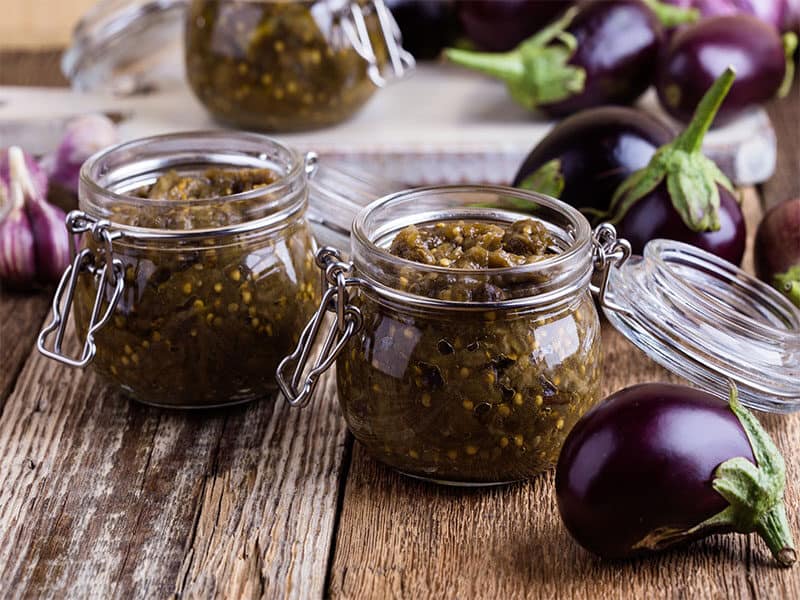
Caviar is a source of omega 3, which helps to promote a healthy nervous, circulatory, and immune system, minerals, and vitamins. Sturgeon and other fishes contain eicosapentaenoic acid (EPA), docosahexaenoic acid (DHA), and long-chain omega-3 fatty acids.
Fish consumption was also associated with healthy people with a reduced risk of sudden cardiac death. There are indications that daily consumption of fish is a factor in the normal fetal brain and eye development by pregnant women and women who may become pregnant.
Function Brain & Body
Caviar is also high in selenium, an essential antioxidant to prevent all effects of free radicals that work with Vitamin E. Selenium has many health benefits, including supporting the immune system and boosting cognitive function.
Researchers have found that selenium is essential for the healthy function of the thyroid. It is best to combine your intake of this delicacy with fresh vegetables such as cabbage or lettuce and lean protein with calorie content and relatively high sodium.
Prevent Heart Diseases
Caviar is filled with B12, which will help you fulfill the prescribed daily needs for this vitamin. This vitamin increases red blood cell growth and helps fatty acids perform well.
If you do not get vitamin B12 rich foods, you will experience various concerns, including anaemia, fatigue, tingling, depression, reduced brain function, and numbness in the limbs.
Boost Immune System
The best natural sources of omega-3s are some fish, such as sturgeon and salmon. These acids will reduce the risk of blood clotting, reduce the risk of heart attack or stroke and protect the arteries against hardening.
Omega 3 fatty acids are also required to process white blood cells to produce antibodies if the body is infected. Caviar will also improve the mood of individuals who suffer from depression because of high omega-3s.
Develop Muscle
Caviar is the best sources of phosphorus and calcium generally needed for healthy bones and muscles to work correctly. Furthermore, high amounts of vitamin D can help absorb and utilize calcium from other foodstuffs you consume.
Caviar with minerals and other vitamins will help your mind and body stay sharp and balanced. Vitamin A, vitamin E and vitamin C help to strengthen the immune system. There are also high percentages of the daily value of iron, zinc, calcium, and magnesium in caviar.
Taste the caviar; you will find an excellent addition to your daily diet. You can get a cup of pineapple juice to fulfill the nutrients needed for your body, along with the fish eggs.
From Taste To The Recipes
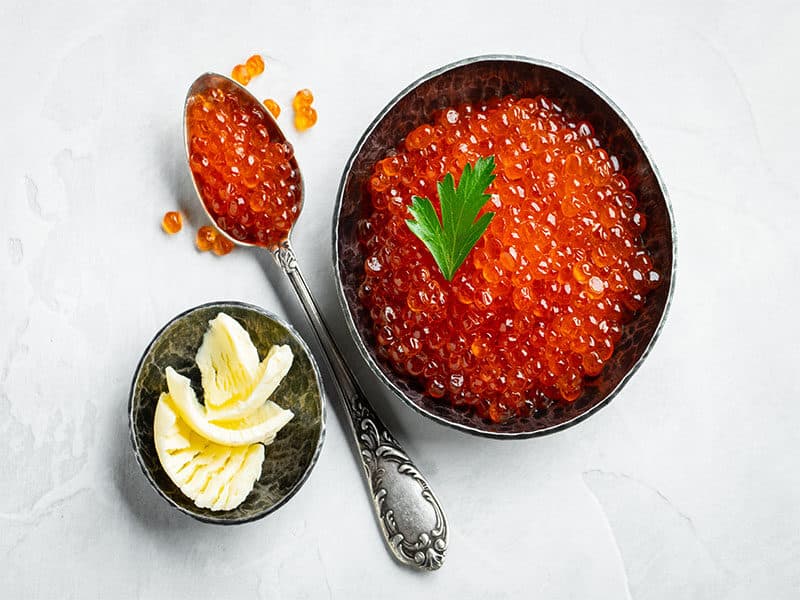
What Is the proper way to taste caviar? You can enjoy the luxurious taste of caviar with a few ingredients in your home’s comfort. Rank up your belove caviar for the dishes and start with me now.
Smoked Salmon Caviar Benedict
With some slices of top-rated smoked salmon, you can create a delight Smoked Salmon Eggs Benedict with Caviar for your perfect Sunday brunch dish.
Further, it’s a breeze for a group gathering with a few tips on garnishing caviar and freezing smoke salmon I have for you. You’re going to love it!
Ingredients
- Caviar
- 4 oz. smoked salmon
- 4 whole eggs
- Egg yolks Hollandaise reduction
- 1⁄2 cup both white wine and champagne vinegar
- 1 shallot (sliced)
- 1⁄2 cup clarified butter
- 1⁄2 teaspoon black peppercorn
- 1 tablespoon white distilled vinegar
- 2 English muffins
- 1 lemon
- 1 oz. fresh spinach
Directions
# Egg Benedict
- Heat the stove to 350oF.
- Place white wine, champagne vinegar, shallot, and black peppercorn in a frying pan or skillet and reduce by half.
- Fill water into the large pan, get to a simmer.
- Fill a saucepot or a steel wok with water halfway, heat it to a simmer over medium heat.
- Melt butter in the small pot then set aside.
- Place hollandaise reduction and egg yolks in a metal bowl.
- Place a metal bowl over a saucepan of simmering water, whisking continuously.
- Take the bowl on and off, constantly whisking till the yolks are thick. Later, remove from the heat.
- Drizzle the butter into the finished yolks with a spoon, whisking the whole time until the butter is firm. Season with salt, lemon juice, and lemon zest.
# English Muffins & Smoked Salmon
- Bake for 6 minutes after splitting the English muffins and placing them on a baking sheet.
- Into a bowl, crack the eggs. In the pot of simmering water, add the white vinegar.
- Add all the eggs while swirling the water, cook for 3 minutes very gently. Take them out into a bowl with some water.
- Place the salmon and spinach above the hot English muffins just right out from the stove. A little lemon juice to sprinkle on.
# Caviar
- Put the poached eggs on top, cover them with the sauce hollandaise and caviar.
- Enjoy the caviar taste with an ice-cold mimosa.
Caviar With Horseradish & Twice-Baked Potatoes
When you overlay with the chosen caviar and spike with horseradish, twice baked potatoes have an exquisite touch. Now you can find an alternative for your potato salads, especially when you are craving but they are freezing.
If you don’t have enough oven space, you can make these in the microwave. Put on your apron to give it a try!
Ingredients
- 2 teaspoons caviar
- 2 tablespoons horseradish
- 2 russet potatoes, scrubbed (medium size)
- 1 tablespoon chopped chives (fresh)
- 1 teaspoon chopped dill and sprigs (fresh for garnish)
- ½ cup reduced-fat sour cream (divided)
- ¼ teaspoon salt
- ¼ cup low-fat milk
- ¼ teaspoon freshly ground pepper
Instructions
- Place the oven preheat at about 400oF.
- With a fork, pierce the potatoes in several places. Bake until tender, 45 to 60 minutes on the center rack. Alternatively, microwave on medium for 20 minutes, turning once or twice.
- Reduce the oven temperature to 375°F.
- Do a half-cut and scoop the insides into a bowl when the potatoes are cool enough. Put the skins in a bit of baking dish.
- To the inside of the potato, add ¼ cup sour cream, horseradish, milk, chives, chopped dill, pepper, and salt. Remember to use the salt grinders for a better load. Mix till smooth with a mixer or mash with a potato masher.
- Bake the stuffed potatoes for about 15 to 20 minutes till the filling is hot. Or microwave 2 to 4 minutes until hot.
- Top each half with½ teaspoon caviar, 1 tablespoon of the remaining sour cream, and a dill sprig to serve.
A note to remember. Bake them on a foil-lined baking sheet to avoid burning if your potatoes are a lot.
Caviar-Cream Cheese Filling Champagne Macarons
If you look for an innovation of your normal desserts made with cream cheese, try this one. Much like the French macaroons, few desserts exploded the pure caviar on the taste. And it must be a miracle when you have these two high-class ingredients into one dish.
You will be happily surprised and delighted to see that the savory creations can be together with rosé, champagne, or a summer white.
Ingredients
The champagne macarons with the Italian meringue method
- 1 cup almond flour
- 1 cup powdered sugar
- 1 teaspoon champagne (pink champagne suggested)
- 3 egg whites (unpasteurized, fresh, and aged at room temperature overnight)
- ½ cup sugar
- ½ teaspoon vanilla extract
- ¼ cup water
The caviar, cream cheese filling
- Caviar (chilled)
- Cream cheese (whipped)
Directions
Macarons
- Sift the sugar (powdered ) with the almond meal/flour. Grind in batches to extract lumps in a food processor (optional).
- Whip the egg whites until achieve stiff peaks.
- To stabilize the egg whites, make a simple syrup by boiling the water and sugar together until it reaches a softball level or 245oF on a candy thermometer.
- Pour the syrups into the egg whites and whip until glossy and stiff.
- Stir in the champagne and vanilla. Extract in the mixture of sugar and almond flour to reach “flow like magma” consistency.
- On top of an insulated baking sheet, pipe one-inch discs on parchment paper. Let the discs air dry for at least 30 minutes to form thin skin.
- Bake for about 15 minutes in a preheated oven at 300oF. Watch the feet grow, but don’t let the macarons brown or burn them. Range by size and pair them.
- Take the macarons out the stove and rest 15 minutes to cool. Peel the parchment paper from the macarons.
Keep French macarons- the Jewish dessert in mind as much as last week you did with the freshly baked donuts.
Filling
- Whip the cream cheese until its consistency spreadable.
- Coat one-half of the macaron shell generously with cream cheese. Assemble a sandwich with another cover on top.
- Using a spreader, press the caviar on the edges of the cream cheese filling.
- Serve as soon as caviar gets perishable.
FAQs
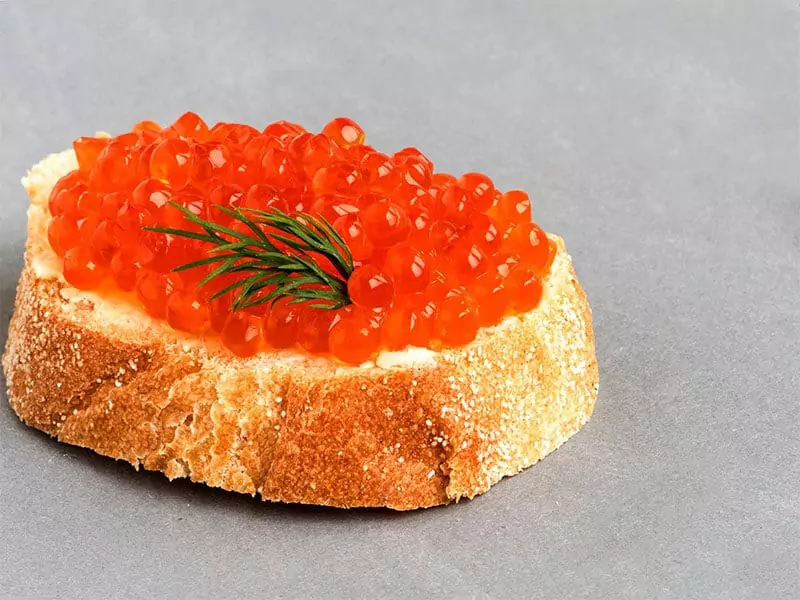
Remember you had caviar for the first time? Is it salty and fishy, with a bit of creamy sour spread on a small fat pancake?
Indeed, very few people fall for the first taste of caviar. The second, third, and fourth bites are necessary to get it. No more hassle, it’s like, where you’ve been my whole life!
Nibble Your Caviar Taste
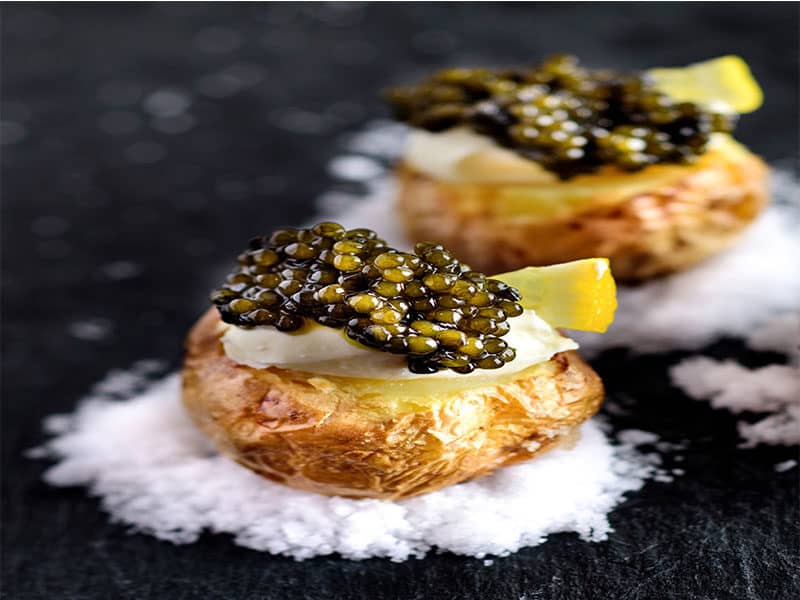
It is caviar if one food is bound to the pure luxury for its taste. Caviar originates from a range of sturgeon varieties, but the rarest, largest, and most valuable caviar is beluga. It earns its tag, ‘black gold,’ at nearly $3.500 per pound.
Before you know whether it is for you or not, try several kinds of caviar. You might figure out that you are irrevocably in love with the particular sturgeon roe. Or which caviar taste you fond of the best for cooking?
Let me know down here your ideas and comments. Take some time to share this post with your home-cook chef mates. Sure, they will be in love with caviar taste since they have more recipes to upgrade the daily dinners into restaurant grade. Hurry up, my chef de cuisine!
